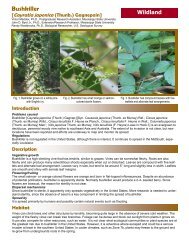RATopic1_95 - Geosystems Research Institute - Mississippi State ...
RATopic1_95 - Geosystems Research Institute - Mississippi State ...
RATopic1_95 - Geosystems Research Institute - Mississippi State ...
Create successful ePaper yourself
Turn your PDF publications into a flip-book with our unique Google optimized e-Paper software.
Effects of Hydrologic Variations on the Growth of Parrotfeather (Myriophyllum aquaticum)<br />
Ryan Wersal and John D. Madsen<br />
Photo 1. Parrotfeather grown at the 0 cm<br />
depth for 12 weeks.<br />
Parrotfeather [Myriophyllum aquaticum (Vell.) Verdc] is a nonnative<br />
aquatic plant from South America that is becoming increasingly problematic<br />
across the Southeastern United <strong>State</strong>s. Currently, little is known<br />
regarding basic biological and ecological processes that impact the<br />
growth of this species. Understanding these processes can result in the<br />
utilization of the most effective control techniques to maximize management,<br />
and can result in the development of predictive tools to identify<br />
susceptible habitats for species invasions.<br />
Photo 2. Parrotfeather regrowth after a 12<br />
week winter drawdown.<br />
Figure 2. Mean (± 1 SE) biomass of parrotfeather<br />
after a winter (bottom) and<br />
summer (drawdown) with durations of 0,<br />
2, 4, 8, and 12 weeks.<br />
In an effort to quantify parrotfeather growth under different hydrologic<br />
regimes three controlled mesocosm studies were conducted. A water<br />
depth manipulation study was conducted in 28, 1900 L tanks in 2008 and<br />
2009. Platforms were suspended within each tank to achieve a water<br />
depth of 0 (< 2 cm), 37, 57, 77, 97, 117, and 138 cm (4 repetitions per<br />
water depth). Six pots of planted parrotfeather were placed on the platforms<br />
and allowed to grow for 12 weeks. At the conclusion of 12 weeks<br />
all pots were harvested, plants dried, and weighed to assess treatment<br />
biomass. Additionally, winter and summer drawdown studies were conducted<br />
to determine plant response in the absence of water. Studies were<br />
conducted in 20, 1100 L tanks from September 2008 to May 2009<br />
(winter drawdown), and February 2009 to September 2009 (summer<br />
drawdown). Pots of planted parrotfeather were placed into tanks designated<br />
as 0<br />
weeks<br />
(reference), 2,<br />
4, 8, and 12<br />
week drawdown<br />
duration. A 4<br />
month growth period<br />
was allowed<br />
prior to drawdown<br />
to ensure a mature<br />
plant stand. The<br />
winter drawdown<br />
was initiated on<br />
January 16, 2009<br />
followed by the<br />
Figure 1. Mean (± 1 SE) biomass of parrotfeather<br />
grown at different water depths for 12 weeks.<br />
summer drawdown<br />
on June 15, 2009. At<br />
these times the water<br />
in each tank was drained and the plants exposed for the designated time<br />
period. After the drawdown duration had lapsed, the designated tanks were<br />
refilled with water and a 4 week recovery period was used to monitor plant<br />
regrowth. At the conclusion of the recovery period, pots with live parrotfeather<br />
were harvested, plants dried, weighed, and compared to the reference<br />
plants to assess drawdown efficacy. Biomass data for all studies were analyzed<br />
using Mixed Procedures models in SAS ® to determine the effects of<br />
water depth on parrotfeather growth as well as differences in a winter vs.<br />
summer drawdown and drawdown duration. Treatment means for all studies<br />
were separated using the LSD method and bars sharing the same letters are<br />
not different at a p = 0.05 level of significance.<br />
2009 USGS Annual Report 11 <strong>Mississippi</strong> <strong>State</strong> University’s <strong>Geosystems</strong> <strong>Research</strong> <strong>Institute</strong>




